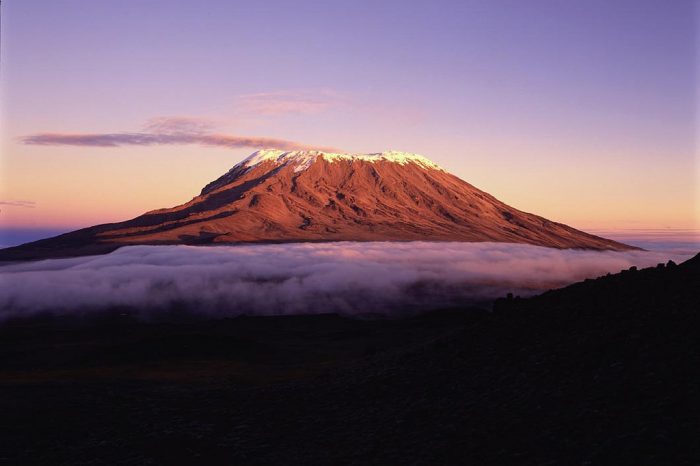MOUNT. MERU
How MOUNT MERU came about:
Following the eruption and vigorous volcanic activity, the magnificent and dramatic terrain of the Arusha National Park was formed on the eastern side of the huge fault known as the Great Rift Valley. Sprouting hot magma, fire and lava into the air 20 million years ago, then collapsing into two big calderas:- the Ngurdoto and Meru craters, which mark the western and eastern boundaries of the 52-square-mile park in the outskirts of Arusha. Depressions in the boiling mud became to form the Momela Lakes. Today, these lakes are fed by underground streams that leach salt from the under soil which is alkaline and support algae, a few small fish, and thousands of birds of various species, especially grebes and flamingo.
Mount Meru remains a volcano, though dormant since its last inception in 1910, a lava-streaked peak rising up to 14,979 feet above sea level surrounded by lush forests and bare rock. The fifth highest mountain in Africa, Mt. Meru is often favored by mild and adventure loving climbers who prefer to avoid the heavier foot traffic on Mt. Kilimanjaro which is situated less than 50 miles away.
Each of the three aforementioned areas of the Mount Meru area, the Ngurdoto Crater, the Momela Lakes, and Mt. Meru, contains a certain flora and fauna (plants and animals) suited to adapt to its particular altitude and geology of the environment. The Ngurdoto Crater is surrounded by montage forests and marshy swamps cover the crater floor. The forests boast of hosting a wide range of tree species, from common cedars to varieties that are so rare outside of Africa such that others have no popular names existing for them in English. Some of the trees bear fruits like mangoes, olives, dates and figs. Primates swing from tree to tree, rule the branches of course feed on the fruits while the herbs provide them the necessary medication. Olive-colored baboon mothers carry their babies like little jockeys, while mature males perch pensively nearby, watching the pack wisely from poodle-nosed faces circled by full manes in territories.
The Mount Meru ascend is quite steep, the route to the summit goes through and over streams, through parkland, montage forest, a sort of gigantic heather zone and moorland. The mountain summit is reached by a narrow, barren ridge, which provides stunning views of the marvelous sightings of the Ash Cone that lies several thousand feet below in the crater. At best times and permitting weather, Kilimanjaro can be seen in the West.
BEST TIME TO CLIMB MOUNT MERU
The best time to climb Meru is between October and February.
GAZELLE SAFARIS, TANZANIA
CONTACTS US
Do you have any comments? any suggestions?
Email: info.sales@gazellesafaris.com
Website: www.gazellesafaris.com+255 25 250 2482
FOLLOW US

